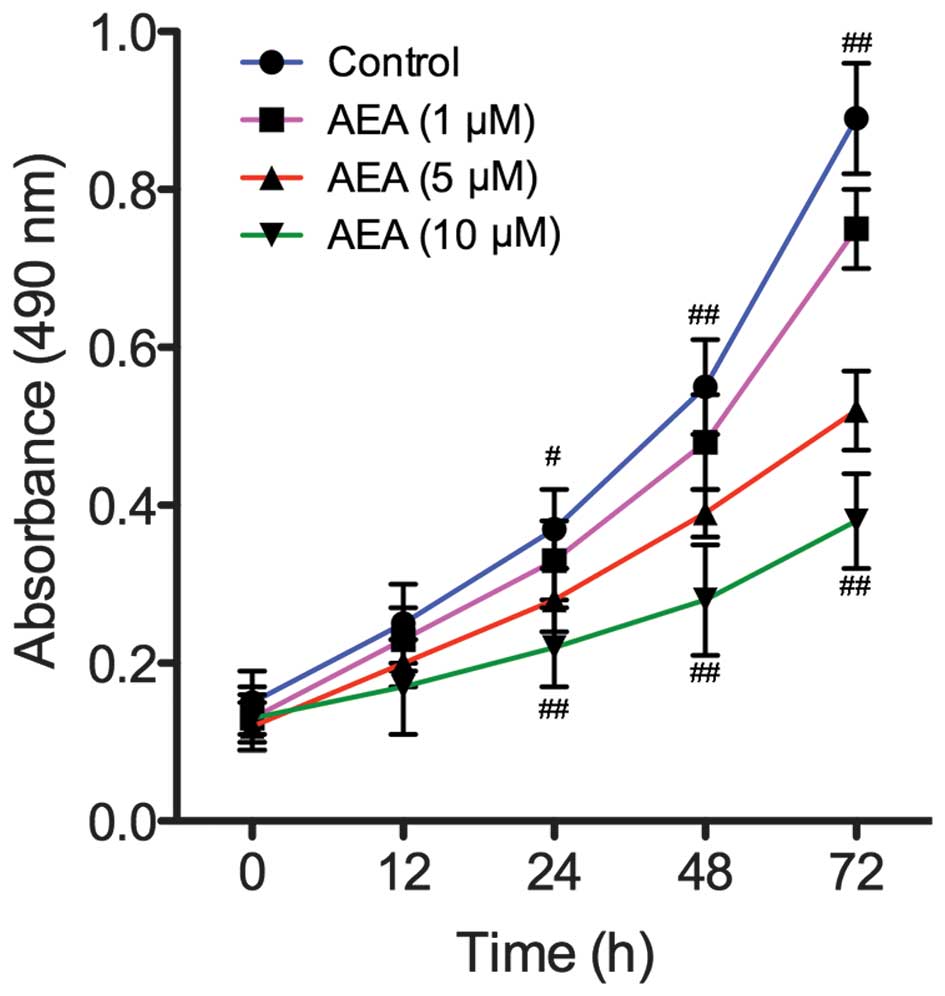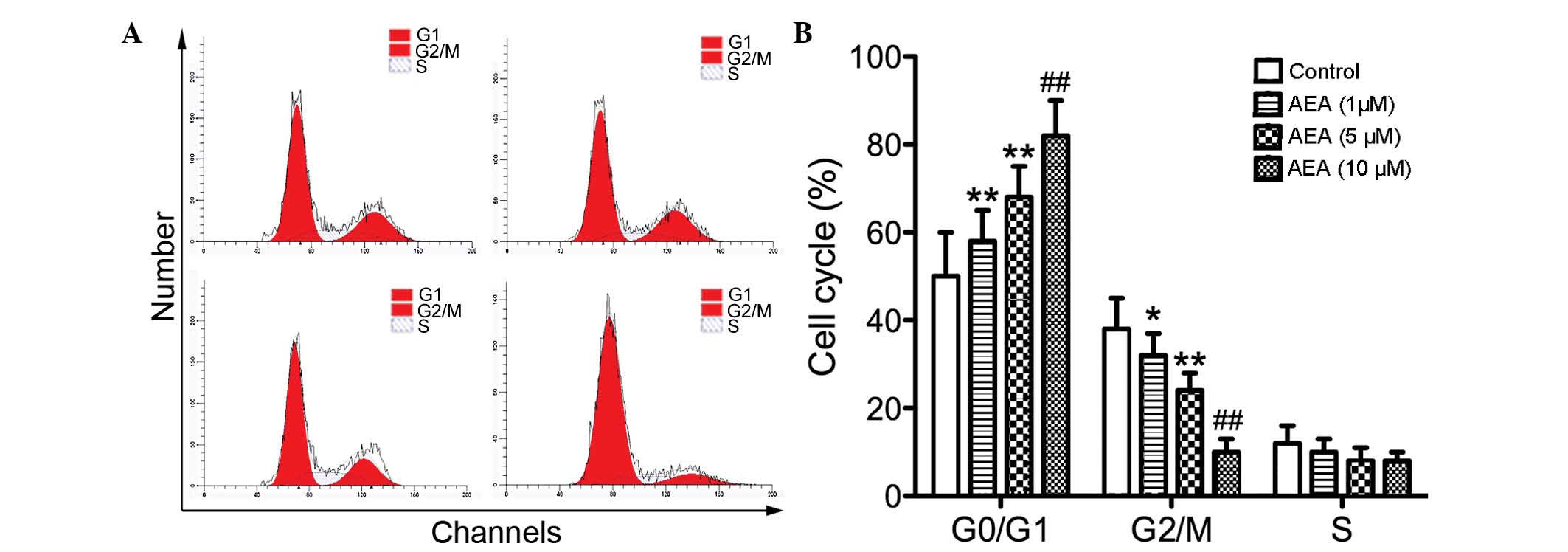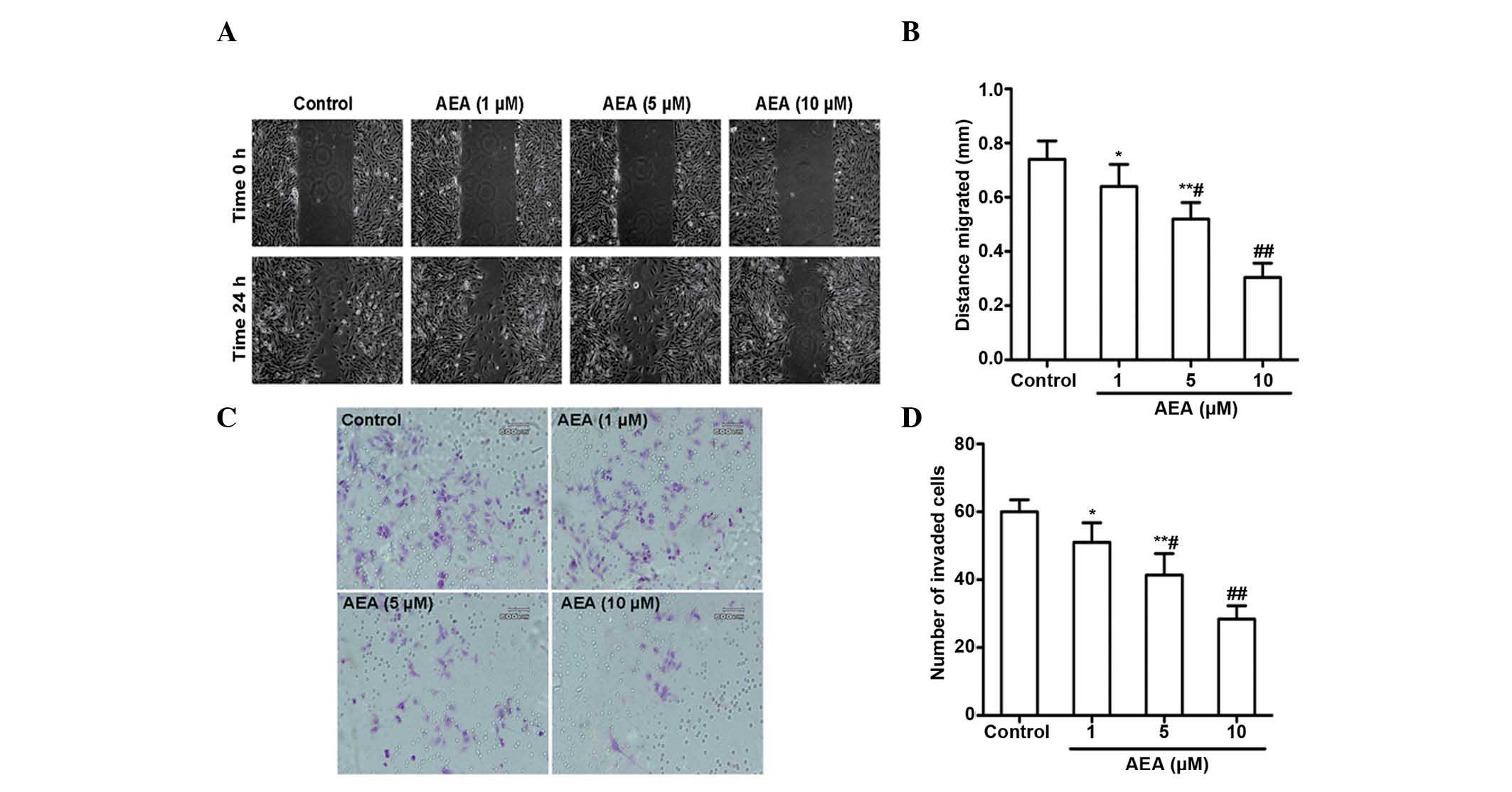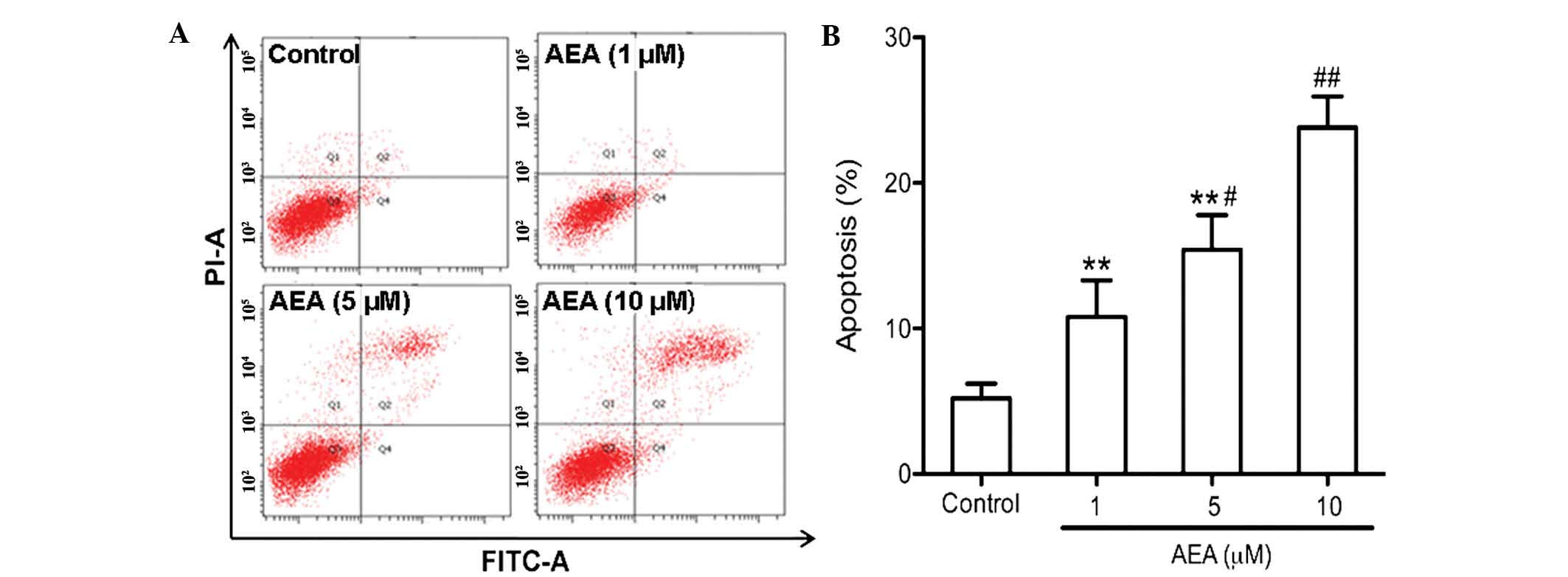Anti‑carcinogenic activity of anandamide on human glioma in vitro and in vivo
Retraction in: /10.3892/mmr.2023.12969
- Authors:
- Published online on: December 28, 2015 https://doi.org/10.3892/mmr.2015.4721
- Pages: 1558-1562
-
Copyright: © Ma et al. This is an open access article distributed under the terms of Creative Commons Attribution License.
Abstract
Introduction
Human gliomas are among the most aggressive cancer types, accounting for ~30–35% of the malignant primary brain tumors in adults. The median survival of patients with the most malignant glioma is ~12 months (1,2). Gliomas are characterized by a high rate of proliferation and a marked propensity to invade the surrounding brain parenchyma. Despite the development of various treatment strategies, including surgery, chemotherapy, and radiotherapy, limited progress has been achieved in the design of therapeutic strategies for glioma.
Cannabinoids are a class of hydrophobic substances found in Cannabis sativa, which have been used as drugs for several centuries to treat a range of medical conditions, including analgesia, emesis and inflammation. Currently, there is a burgeoning interest in the study of the therapeutic effects of cannabinoids in different cancer types. It was demonstrated that cannabinoids and their derivatives exert anti-proliferative, pro-apoptotic, anti-migratory and anti-invasive actions in a wide spectrum of cancer cells in culture (3–5). δ9-Tetrahydrocannabinol, a cannabinoid, was reported to induce apoptosis in glioma cells through modulating the activity of the sphingomyelin cycle (6). Mammalian tissues possess at least two types of cannabinoid receptors (CB-Rs) (7). CB-Rs are G-protein-coupled transmembrane receptors. The subsequent signaling pathways negatively regulate adenyl cyclase and activate mitogen-activated protein kinase (MAPK), and ultimately influence biological processes, including cell apoptosis (8). The endocannabinoid system comprises an array of endogenously produced bioactive lipids, which activate CB-Rs. Arachidonoyl ethanolamide, also termed anandamide (AEA), was the first agonist of CB-R to be identified, and it is the most important endocannabinoid (9). AEA is involved in regulating multiple physiological and pathological conditions, including immunomodulation, chronic pain, inflammation and carcinogenesis. Mounting evidence suggests that AEA also exerts its anti-tumor effects by decreasing cell proliferation, as well as modulating angiogenesis and metastasis in a number of cancer cell types, including breast, hepatic, colorectal and gastric cancer (4,10–13). However, to the best of our knowledge, no previous study has reported the anti-tumor effects of AEA on human glioma. Therefore, the present study was designed to investigate the inhibitory effects of AEA on the proliferation of human glioma cells. This investigation also aimed to addressed whether AEA may reduce the migration and invasive ability of glioma cells.
Materials and methods
Cell culture
All experiments were performed in accordance with the guidelines of the Ethics Committee of Wuhan University (Hubei, China). The human glioblastoma U251 cells were obtained from American Type Culture Collection (Manassas, VA, USA). The U251 cells were maintained in Dulbecco's modified Eagle's medium (Hyclone Laboratories, Inc., Logan, UT, USA), supplemented with 10% fetal bovine serum (FBS; Hyclone Laboratories, Inc.) at 37°C in a humidified 5% CO2/95% air atmosphere.
Cell viability and proliferation assay
Cell proliferation was assessed using an MTT assay. The cells were seeded at a density of 1×105 cells/ml in 96-well plates, containing 10% FBS (SSCBT, Shanghai, China). Following 24 h incubation to allow for attachment, the medium was removed and replaced with fresh culture medium, containing AEA (Tocris Bioscience, St. Louis, MO, USA) at increasing concentrations (1, 5 and 10 µM). Following incubation for a further 12, 24, 48 or 72 h, the proliferative response was estimated using the MTT assay. MTT solution (10 µl; 5 mg/ml; Sigma-Aldrich, St Louis, MO, USA) in phosphate-buffered saline (PBS; Boster, Wuhan, China) was added to medium in the wells, and the microplate was incubated at 37°C for 4 h. Untreated cells served as a control. The absorbance was measured by a microplate reader (680; Bio-Rad, Hercules, CA, USA) at 490 nm, and experiments were performed in triplicate.
Migration and invasion assay
The cells were assessed for their migratory and invasive capabilities using 8 µm pore transwell inserts (BD BioCoat™; BD Biosciences, San Jose, CA, USA). The upper side of the transwell inserts, with 8-µm pores, were either uncoated (for migration) or coated (for invasion) with Matrigel matrix (BD Biosciences). Following treatment with AEA (1, 5 or 10 µM) and incubation for 24 h, the U251 cells were added into the upper chamber at a density of 1×105/ml. The lower portion of the chamber contained 0.1% bovine serum albumin-DMEM without serum (Sigma-Aldrich). Following incubation for a further 24 h, the cells on the upper side were removed and subsequently stained with hematoxylin-eosin. The extent of migration and invasion was determined by counting the cells in five randomly selected areas under a light microscope (Nikon Eclipse TE2000-U, Nikon, Tokyo, Japan).
Cell cycle analysis
The cells were seeded into plates in DMEM, containing 10% fetal calf serum (Invitrogen, Shanghai, China). Following incubation with AEA (1, 5 or 10 µM) for 24 h, the cells were harvested, rinsed with cold PBS and fixed with 70% ice-cold ethanol for 48 h at 4°C. The fixed cells were rinsed with cold PBS, followed by an incubation with PBS, containing 10 mg/ml propidium iodide (PI; Sigma-Aldrich) and 0.5 mg/ml ribonuclease A (Sigma-Aldrich) for 15 min at 37°C. The DNA content of the labeled cells was determined using fluorescence-activated cell sorting caliber flow cytometry (FACSAria III; BD Biosciences).
Apoptosis assay
Flow cytometric analysis was used to determine the apoptotic rate of the cells. The surface exposure of phosphatidylserine in the apoptotic cells was quantitatively measured using the annexin V-APC apoptosis detection kit (eBioscience Inc., San Diego, CA, USA), according to the manufacturer's instructions. Briefly, following treatment of the cells with 1, 5 or 10 µM AEA for 24 h, the U251 cells were incubated with 5 µl annexin V-fluorescein isothiocyanate (BD Biosciences) and 5 µl PI for 15 min. Annexin V-positive and PI-negative cells were identified as the cells which were undergoing apoptosis. The apoptotic rate was determined using CellQuest 3.0 software (BD Biosciences).
Tumor growth in vivo
Specific pathogen-free male BALB/c-nu mice (weighing 22–26 g) were purchased from the Center for Animal Experiments of Wuhan University (Hubei, China). The present study was approved by the Institute of Animal Care and Use Committee of Wuhan University, and all experiments were performed in accordance with the guidelines of the Animal Use and Care Committee of Wuhan University. Equal numbers of U251 cells with 200 ml normal saline were injected subcutaneously into the right flank tissue of nude mice to establish the model. Subsequently, 40 mice were randomly divided into four groups (n=10 per group), and the mice were administered normal saline, 15, 150 and 1,500 pmol/kg of AEA in each group, respectively. Over a 40 day observation period, the nude mice were monitored daily and the sizes of transplanted tumors were measured by slide caliper every 5 days. The maximum diameter, a, and the minimum diameter, b (mm), of the tumor masses were measured with a digital caliper every 2 days. The size of the tumors was measured twice in an identical way by two different experimenters, in a blinded manner. The tumor volume (V) was calculated (mm3) according to the following equation: (a × b2)/2. Growth curves were subsequently produced according to the size of the tumor volume.
Statistical analysis
Data are expressed as the mean ± standard deviation. Comparisons among all groups were performed with one-way analysis of variance or the unpaired Student's t-test. P<0.05 was considered to indicate a statistically significant difference. All statistical analyses were performed using SPSS 21.0 software (IBM SPSS, Chicago, IL, USA). The results shown are representative of at least three independent experiments.
Results
Effects of AEA on cell proliferation
To assess the effect of AEA on the growth of U251 cells, viability curves for U251 cells were determined using an MTT assay. As shown in Fig. 1, the growth of the cells treated with AEA was markedly inhibited compared with the control group (P<0.05). In addition, the treatment of U251 cells with AEA was associated with a dose- and time-dependent inhibition of cell growth.
Effects of AEA on the cell cycle
To investigate the effect of AEA on cell cycle progression, flow cytometry was performed to determine the cell cycle distribution. Compared with the control group, the cells treated with AEA accumulated in the G0/G1 phase, whereas the percentage of cell numbers in G2/M phase was decreased (Fig. 2). These results suggested that AEA treatment delays cell cycle progression and cell proliferation.
Effects of AEA on cell migration and invasion
The effects of AEA on the migration and invasive ability of the U251 cells was investigated. As expected, a marked reduction in the migration of the U251 cells occurred upon treatment with AEA (1, 5 and 10 µM) for 24 h (Fig. 3A and B). AEA also markedly reduced the invasive potential of the U251 cells through the Matrigel (Fig. 3C and D). All these inhibitory effects elicited by AEA on cell migration and invasive ability were dose-dependent.
Effects of AEA on cell apoptosis
An annexin V apoptosis assay was performed to determine the apoptotic effect of AEA on the U251 cells. As determined by flow cytometric analysis, AEA markedly increased the percentage of apoptotic cells in a dose-dependent manner (P<0.05; Fig. 4).
Effects of AEA on tumor growth in vivo
The present study demonstrated that AEA efficiently inhibited cell proliferation, induced G0/G1 cell cycle arrest, and suppressed the migration and invasion of the U251 cells in vitro. The effects of AEA on tumor growth in vivo were also investigated. As shown in Fig. 5, tumor growth was delayed in the mice injected with AEA, and the average tumor volume 40 days following transplantation was markedly decreased compared with the control group (P<0.05).
Discussion
Mounting evidence suggests that endocannabinoids may have neuroprotective (14) and anti-tumor effects (12,15), in addition to their common use as appetite stimulants and anti-emetic agents. Data from numerous previous studies demonstrated the anti-carcinogenetic properties of endocannabinoids, particularly AEA. In the present study, it was demonstrated that AEA significantly reduced the proliferation rate of human glioma U251 cells in a time- and dose-dependent manner. In addition, AEA also induced cell apoptosis, with an accumulation of cells observed in the G0/G1 phase. The precise mechanisms through which AEA may influence neoplastic cell growth remain to be fully elucidated. On the one hand, AEA may exert its effects via CB-Rs. CB-Rs are G-protein-coupled transmembrane receptors, and CB-R-coupled G-proteins are involved in various signal transduction pathways, including the inhibition of adenylyl cyclase, and the activation of the focal adhesion kinase (FAK) and MAPK pathways (16). For example, AEA elicited a marked anti-proliferative effect on breast cancer cells through CB-R-mediated inhibition of adenylate cyclase and activation of extracellular signal-regulated kinase (ERK) (17). In glioma cells, the activation of CB-R was demonstrated to be a process involved in programmed cell death, with subsequent ceramide accumulation and Raf1/ERK activation (18). Therefore, the present study investigated whether the anti-proliferative and apoptosis-inducing effects of AEA in the U251 glioma cell line may be due to, or at least partly due to, activation of CB-Rs. An increasing number of previous studies supported a role for AEA as an agonist of type-1 vanilloid receptor (VR1) (19–21). The activation of VR1 by binding of AEA triggered a rise in intracellular calcium, followed by activation of cyclo-oxygenase and lipoxygenase, and of caspases, ultimately leading to cellular apoptosis (22). The mechanisms of AEA-induced apoptosis and the anti-proliferative effects in glioma cells remain to be elucidated in further studies.
The present study also demonstrated that AEA inhibited cell migration and invasion of U251 cells. These results were determined by in vitro assays on type IV collagen, a major component of the basement membrane. Cell migration and invasion are of paramount importance in the pathological processes of tumor cell metastasis. These pathophysiological processes exert pivotal roles in glioma development and growth, even during the earliest phase (23), providing potential targets for therapeutic intervention. Results from other laboratories demonstrated that AEA markedly reduces invasion and metastasis of breast cancer cells in vivo and in vitro by downregulating the phosphorylation of FAK (24). FAK is an ~120 kDa protein, which was first identified as a major integrin-dependent, tyrosine-phosphorylated protein localized in focal adhesions (25). Numerous previous studies over the last 20 years established FAK as a central mediator of integrin signaling, as well as an important component of signaling mediated by other cell surface receptors. FAK signaling has been demonstrated to promote metastasis and angiogenesis in various cancer types (26). Inhibition of FAK activation markedly reduced the tumor burden and prolonged the survival rate over time in experimental models of tumors, which indicates that FAK may be a suitable target for therapeutic intervention in invasive tumors, including glioma. Therefore, it was hyopthesized that AEA may have potential therapeutic effects in preventing metastasis of human glioma.
In conclusion, the present study has demonstrated that AEA reduces cell proliferation, migration and invasion, induces apoptosis in glioma cells, and inhibits tumor growth in vivo, suggesting that AEA may be a putative therapeutic agent for the treatment of glioma.
Acknowledgments
The authors would like to thank the Center for Medical Experiment (Zhongnan Hospital of Wuhan University, Wuhan, China) for technical assistance.
References
|
Takahashi S, Hirose Y, Ikeda E, Fukaya R and Kawase T: Chromosome arm 1q gain associated with good response to chemotherapy in a malignant glioma. Case report. J Neurosurg. 106:488–494. 2007. View Article : Google Scholar : PubMed/NCBI | |
|
Takahashi S, Yamada-Okabe H, Hamada K, Ohta S, Kawase T, Yoshida K and Toda M: Downregulation of uPARAP mediates cytoskeletal rearrangements and decreases invasion and migration properties in glioma cells. J Neurooncol. 103:267–276. 2011. View Article : Google Scholar | |
|
Hernán Pérez de la Ossa D, Gil-Alegre ME, Ligresti A, Aberturas Mdel R, Molpeceres J, Torres AI and Di Marzo V: Preparation and characterization of Δ(9)-tetrahydrocannabinol-loaded biodegradable polymeric microparticles and their antitumoral efficacy on cancer cell lines. J Drug Target. 21:710–718. 2013. View Article : Google Scholar | |
|
Caffarel MM, Andradas C, Pérez-Gómez E, Guzmán M and Sánchez C: Cannabinoids: A new hope for breast cancer therapy? Cancer Treat Rev. 38:911–918. 2012. View Article : Google Scholar : PubMed/NCBI | |
|
Velasco G, Sánchez C and Guzmán M: Towards the use of cannabinoids as antitumour agents. Nat Rev Cancer. 12:436–444. 2012. View Article : Google Scholar : PubMed/NCBI | |
|
Sánchez C, Galve-Roperh I, Canova C, Brachet P and Guzmán M: Delta9-tetrahydrocannabinol induces apoptosis in C6 glioma cells. FEBS Lett. 436:6–10. 1998. View Article : Google Scholar : PubMed/NCBI | |
|
Di Marzo V and De Petrocellis L: Why do cannabinoid receptors have more than one endogenous ligand? Philos Trans R Soc Lond B Biol Sci. 367:3216–3228. 2012. View Article : Google Scholar : PubMed/NCBI | |
|
Bosier B, Muccioli GG, Hermans E and Lambert DM: Functionally selective cannabinoid receptor signalling: Therapeutic implications and opportunities. Biochem Pharmacol. 80:1–12. 2010. View Article : Google Scholar : PubMed/NCBI | |
|
Mechoulam R and Hanus L: A historical overview of chemical research on cannabinoids. Chem Phys Lipids. 108:1–13. 2000. View Article : Google Scholar : PubMed/NCBI | |
|
Pisanti S, Borselli C, Oliviero O, Laezza C, Gazzerro P and Bifulco M: Antiangiogenic activity of the endocannabinoid anandamide: Correlation to its tumor-suppressor efficacy. J Cell Physiol. 211:495–503. 2007. View Article : Google Scholar | |
|
Miyato H, Kitayama J, Yamashita H, Souma D, Asakage M, Yamada J and Nagawa H: Pharmacological synergism between cannabinoids and paclitaxel in gastric cancer cell lines. J Surg Res. 155:40–47. 2009. View Article : Google Scholar : PubMed/NCBI | |
|
Linsalata M, Notarnicola M, Tutino V, Bifulco M, Santoro A, Laezza C, Messa C, Orlando A and Caruso MG: Effects of anandamide on polyamine levels and cell growth in human colon cancer cells. Anticancer Res. 30:2583–2589. 2010.PubMed/NCBI | |
|
Xie C, Liu G, Liu J, Huang Z, Wang F, Lei X, Wu X, Huang S, Zhong D and Xu X: Anti-proliferative effects of anandamide in human hepatocellular carcinoma cells. Oncol Lett. 4:403–407. 2012.PubMed/NCBI | |
|
Fride E: The endocannabinoid-CB receptor system: Importance for development and in pediatric disease. Neuro Endocrinol Lett. 25:24–30. 2004.PubMed/NCBI | |
|
Patsos HA, Hicks DJ, Greenhough A, Williams AC and Paraskeva C: Cannabinoids and cancer: Potential for colorectal cancer therapy. Biochem Soc Trans. 33:712–714. 2005. View Article : Google Scholar : PubMed/NCBI | |
|
Maccarrone M and Finazzi-Agró A: The endocannabinoid system, anandamide and the regulation of mammalian cell apoptosis. Cell Death Differ. 10:946–955. 2003. View Article : Google Scholar : PubMed/NCBI | |
|
Melck D, De Petrocellis L, Orlando P, Bisogno T, Laezza C, Bifulco M and Di Marzo V: Suppression of nerve growth factor Trk receptors and prolactin receptors by endocannabinoids leads to inhibition of human breast and prostate cancer cell proliferation. Endocrinology. 141:118–126. 2000. | |
|
Galve-Roperh I, Sánchez C, Cortés ML, Gómez del Pulgar T, Izquierdo M and Guzmán M: Anti-tumoral action of cannabinoids: Involvement of sustained ceramide accumulation and extracellular signal-regulated kinase activation. Nat Med. 6:313–319. 2000. View Article : Google Scholar : PubMed/NCBI | |
|
Smart D, Gunthorpe MJ, Jerman JC, Nasir S, Gray J, Muir AI, Chambers JK, Randall AD and Davis JB: The endogenous lipid anandamide is a full agonist at the human vanilloid receptor (hVR1). Br J Pharmacol. 129:227–230. 2000. View Article : Google Scholar : PubMed/NCBI | |
|
Al-Hayani A, Wease KN, Ross RA, Pertwee RG and Davies SN: The endogenous cannabinoid anandamide activates vanilloid receptors in the rat hippocampal slice. Neuropharmacology. 41:1000–1005. 2001. View Article : Google Scholar : PubMed/NCBI | |
|
Tóth A, Blumberg PM and Boczán J: Anandamide and the vanilloid receptor (TRPV1). Vitam Horm. 81:389–419. 2009. View Article : Google Scholar : PubMed/NCBI | |
|
Maccarrone M, Lorenzon T, Bari M, Melino G and Finazzi-Agro A: Anandamide induces apoptosis in human cells via vanilloid receptors. Evidence for a protective role of cannabinoid receptors. J Biol Chem. 275:31938–31945. 2000. View Article : Google Scholar : PubMed/NCBI | |
|
Zhang X, Zhang W, Mao XG, Zhen HN, Cao WD and Hu SJ: Targeting role of glioma stem cells for glioblastoma multiforme. Curr Med Chem. 20:1974–1984. 2013. View Article : Google Scholar : PubMed/NCBI | |
|
Grimaldi C, Pisanti S, Laezza C, Malfitano AM, Santoro A, Vitale M, Caruso MG, Notarnicola M, Iacuzzo I, Portella G, et al: Anandamide inhibits adhesion and migration of breast cancer cells. Exp Cell Res. 312:363–373. 2006. View Article : Google Scholar | |
|
Zhao X and Guan JL: Focal adhesion kinase and its signaling pathways in cell migration and angiogenesis. Adv Drug Deliv Rev. 63:610–615. 2011. View Article : Google Scholar : | |
|
Golubovskaya VM and Cance WG: Focal adhesion kinase and p53 signaling in cancer cells. Int Rev Cytol. 263:103–153. 2007. View Article : Google Scholar : PubMed/NCBI |














